Studies in Bibliography
As I said in my last post, I’m headed off to Rare Book School at UVa next week. I haven’t been before, but I have spent a week at some kind of institute for the last three summers (so far there is a lot more Latin at RBS than at DHSI or HILT). The recommended reading for my course, Scholarly Editing: Principles and Practice, is a series of six essays by G. Thomas Tanselle. The series starts in 1975 and continues through 2000, creating a pretty dense snapshot of the scholarly editing conversation during that time. Certainly a 300-page lit review is one way to get up to speed on a field, if only Tanselle didn’t spend most of the time tearing apart everyone else’s arguments while simultaneously accusing them of being too polemical.
In the first essay (1975), Tanselle explains the principles of W. W. Greg’s “The Rationale of Copy-Text,” which are, in my own words:
- Editors should use restraints and should not rely on purely “ecletic methods.”
- The last edition published in the author’s lifetime is not automatically the best.
- Substantive variants matter more than accidental ones. Because, authors are more likely to concern themselves with substantive changes and copyists etc. with “accidentals.”
- Be reasonable. Know when to use the rules and when not to.
Tanselle then spends the next twenty-five years criticizing other scholars for misunderstanding Greg. While he finds some questions interesting, he claims that most publications do very little to advance the field. In his view, most scholars are pushing aside Greg and what they see as his preference for authorial intent because of a new focus on the social context of literary production. Tanselle sees these arguments as misguided and spends a lot of saying so - he thinks that Greg still accommodates most of these points of view and that everyone else just doesn’t get it:
The real myth involved is the belief that intentionalist editing does not accommodate collaborative authorship and textual instability. (SiB vol 49 (1996): 5)
By 1996, he’s a little less salty and ends by quoting Woolf to illustrate his point - “a novel… exists on the far side of a gulf.” Editors are just trying to reconstruct the whole story from what is ultimately a textual artifact (just like other historical fields). If you get past authorial intent, the question becomes: what’s the point of a critical edition? Tanselle’s answer: “the limitations of artifacts and insatiability of our interest in the past” (60).
Of course I was interested in mentions of the digital, which mostly come up with McGann and Schillingsburg. Tanselle sees digital editions as improving on an often awkward print apparatus or to enable McGann’s “radial reading.” But what struck me from the whole 300 page slog (and it was a big of a slog) was the resonance of textual studies in DH, or even info lit more broadly. DocNow’s diffengine came to mind for instance. If you believe that remediation is a thing and that form informs content, or that authority is constructed and contextual, then you can’t skate past textual studies. We have more tools now for tracking changes to text by whichever contributor, but I can’t imagine there are many who would argue that text is more stable now than it’s ever been.
In case you’re wondering, Huxley roots for authorial intent while Orwell falls into the post-structuralist camp.
 |  |
